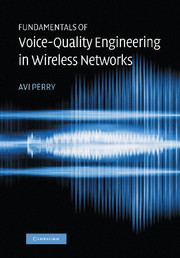Book contents
- Frontmatter
- Contents
- Preface
- List of abbreviations
- Introduction
- Part I Voice-quality foundations
- Part II Applications
- Part III Wireless architectures
- 7 Mobile-to-mobile stand-alone VQS architectures and their implications for data communications
- 8 The VQS evolution to 3G
- Part IV A network operator's guide for selecting, appraising, and testing a VQS
- Part V Managing the network
- Part VI Afterthoughts and some fresh ideas
- Part VII Recordings
- Glossary of common voice-quality systems terminology
- Brief summary of echo cancelation and VQS major standards
- Brief summary of key voice-quality assessment standards
- Bibliography
- Index
7 - Mobile-to-mobile stand-alone VQS architectures and their implications for data communications
Published online by Cambridge University Press: 24 May 2010
- Frontmatter
- Contents
- Preface
- List of abbreviations
- Introduction
- Part I Voice-quality foundations
- Part II Applications
- Part III Wireless architectures
- 7 Mobile-to-mobile stand-alone VQS architectures and their implications for data communications
- 8 The VQS evolution to 3G
- Part IV A network operator's guide for selecting, appraising, and testing a VQS
- Part V Managing the network
- Part VI Afterthoughts and some fresh ideas
- Part VII Recordings
- Glossary of common voice-quality systems terminology
- Brief summary of echo cancelation and VQS major standards
- Brief summary of key voice-quality assessment standards
- Bibliography
- Index
Summary
Introduction
Chapter 7 reviews the optional placements of the VQS functions relative to the mobile-switching center and the base-station controller, since placement impacts voice performance, applications, deployment cost, and data-detection algorithms. The first section of this chapter covers wireless-network architectures that provide comprehensive signal processing coverage for mobile-to-mobile call applications. The topic of economics and architectural trade-off associated with voice-enhancement systems is also addressed. The second part of the chapter presents an analysis of the techniques employed by a voice-quality system when coping with data communications without interfering or blocking its error-free transmission. The analysis includes descriptions of data-detection algorithms based on bit-pattern recognitions. The scope encompasses circuit-switched and high-speed circuit-switched data (CSD and HSCSD respectively) services. Finally, the third section describes tandem-free operation (TFO), its potential impact on speech transmission and data communication, and potential features and architectures.
The chapter characterizes two major themes and their joint interplay: (1) mobile-to-mobile network architectures with voice-quality enhancements, and (2) mobile data communications. It elaborates on various applications, technical challenges, and potential solutions. It is also intended to impart a sharper awareness of where technology is heading, and what constitutes winning features in the race to provide products that deliver superior voice quality in the wireless-communications arena.
The surge in data communications has spilled its fervor into wireless applications. Demand for higher-speed data access and the remarkable growth of internet applications have fueled the growth of this industry.
- Type
- Chapter
- Information
- Fundamentals of Voice-Quality Engineering in Wireless Networks , pp. 147 - 162Publisher: Cambridge University PressPrint publication year: 2006



